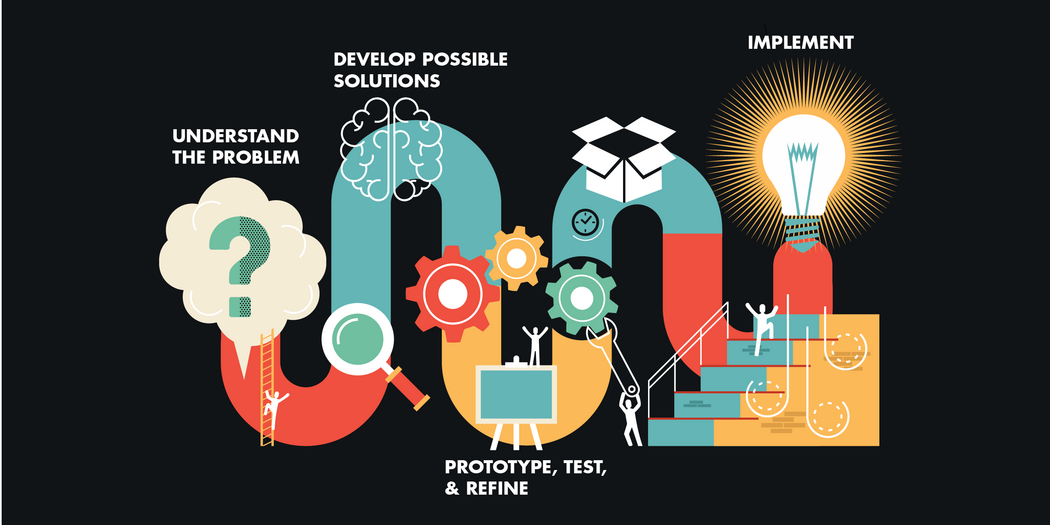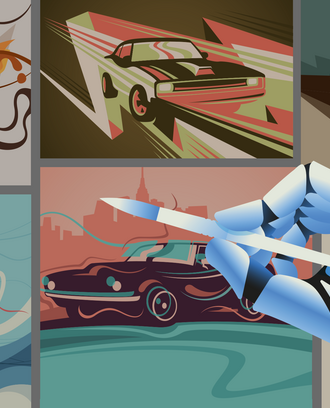Credit: Mimi Phan
What is design thinking?
Design thinking is an innovative problem-solving process rooted in a set of skills.The approach has been around for decades, but it only started gaining traction outside of the design community after the 2008 Harvard Business Review article [subscription required] titled “Design Thinking” by Tim Brown, CEO and president of design company IDEO.
Since then, the design thinking process has been applied to developing new products and services, and to a whole range of problems, from creating a business model for selling solar panels in Africa to the operation of Airbnb.
At a high level, the steps involved in the design thinking process are simple: first, fully understand the problem; second, explore a wide range of possible solutions; third, iterate extensively through prototyping and testing; and finally, implement through the customary deployment mechanisms.
The skills associated with these steps help people apply creativity to effectively solve real-world problems better than they otherwise would. They can be readily learned, but take effort. For instance, when trying to understand a problem, setting aside your own preconceptions is vital, but it’s hard.
Creative brainstorming is necessary for developing possible solutions, but many people don’t do it particularly well. And throughout the process it is critical to engage in modeling, analysis, prototyping, and testing, and to really learn from these many iterations.
Once you master the skills central to the design thinking approach, they can be applied to solve problems in daily life and any industry.
Here’s what you need to know to get started.
Understand the problem
The first step in design thinking is to understand the problem you are trying to solve before searching for solutions. Sometimes, the problem you need to address is not the one you originally set out to tackle.
“Most people don’t make much of an effort to explore the problem space before exploring the solution space,” said MIT Sloan professor Steve Eppinger. The mistake they make is to try and empathize, connecting the stated problem only to their own experiences. This falsely leads to the belief that you completely understand the situation. But the actual problem is always broader, more nuanced, or different than people originally assume.
Take the example of a meal delivery service in Holstebro, Denmark. When a team first began looking at the problem of poor nutrition and malnourishment among the elderly in the city, many of whom received meals from the service, it thought that simply updating the menu options would be a sufficient solution. But after closer observation, the team realized the scope of the problem was much larger, and that they would need to redesign the entire experience, not only for those receiving the meals, but for those preparing the meals as well. While the company changed almost everything about itself, including rebranding as The Good Kitchen, the most important change the company made when rethinking its business model was shifting how employees viewed themselves and their work. That, in turn, helped them create better meals (which were also drastically changed), yielding happier, better nourished customers.
Involve users
Imagine you are designing a new walker for rehabilitation patients and the elderly, but you have never used one. Could you fully understand what customers need? Certainly not, if you haven’t extensively observed and spoken with real customers. There is a reason that design thinking is often referred to as human-centered design.
“You have to immerse yourself in the problem,” Eppinger said.
How do you start to understand how to build a better walker? When a team from MIT’s Integrated Design and Management program together with the design firm Altitude took on that task, they met with walker users to interview them, observe them, and understand their experiences.
“We center the design process on human beings by understanding their needs at the beginning, and then include them throughout the development and testing process,” Eppinger said.
Central to the design thinking process is prototyping and testing (more on that later) which allows designers to try, to fail, and to learn what works. Testing also involves customers, and that continued involvement provides essential user feedback on potential designs and use cases. If the MIT-Altitude team studying walkers had ended user involvement after its initial interviews, it would likely have ended up with a walker that didn’t work very well for customers.
It is also important to interview and understand other stakeholders, like people selling the product, or those who are supporting the users throughout the product life cycle.
Go wild!
The second phase of design thinking is developing solutions to the problem (which you now fully understand). This begins with what most people know as brainstorming.
Hold nothing back during brainstorming sessions — except criticism. Infeasible ideas can generate useful solutions, but you’d never get there if you shoot down every impractical idea from the start.
“One of the key principles of brainstorming is to suspend judgment,” Eppinger said. “When we're exploring the solution space, we first broaden the search and generate lots of possibilities, including the wild and crazy ideas. Of course, the only way we're going to build on the wild and crazy ideas is if we consider them in the first place.”
That doesn’t mean you never judge the ideas, Eppinger said. That part comes later, in downselection. “But if we want 100 ideas to choose from, we can’t be very critical.”
In the case of The Good Kitchen, the kitchen employees were given new uniforms. Why? Uniforms don’t directly affect the competence of the cooks or the taste of the food.
But during interviews conducted with kitchen employees, designers realized that morale was low, in part because employees were bored preparing the same dishes over and over again, in part because they felt that others had a poor perception of them. The new, chef-style uniforms gave the cooks a greater sense of pride. It was only part of the solution, but if the idea had been rejected outright, or perhaps not even suggested, the company would have missed an important aspect of the solution.
Prototype and test. Repeat.
You’ve defined the problem. You’ve spoken to customers. You’ve brainstormed, come up with all sorts of ideas, and worked with your team to boil those ideas down to the ones you think may actually solve the problem you’ve defined.
What next?
“We don’t develop a good solution just by thinking about a list of ideas, bullet points and rough sketches,” Eppinger said. “We explore potential solutions through modeling and prototyping. We design, we build, we test, and repeat — this design iteration process is absolutely critical to effective design thinking.”
Repeating this loop of prototyping, testing, and gathering user feedback is crucial for making sure the design is right — that is, it works for customers, you can build it, and you can support it.
“After several iterations, we might get something that works, we validate it with real customers, and we often find that what we thought was a great solution is actually only just OK. But then we can make it a lot better through even just a few more iterations,” Eppinger said.
Implementation
The goal of all the steps that come before this is to have the best possible solution before you move into implementing the design. Your team will spend most of its time, its money, and its energy on this stage.
“Implementation involves detailed design, training, tooling, and ramping up. It is a huge amount of effort, so get it right before you expend that effort,” said Eppinger.
Think big
Design thinking isn’t just for “things.” If you are only applying the approach to physical products, you aren’t getting the most out of it. Design thinking can be applied to any problem that needs a creative solution. When Eppinger ran into a primary school educator who told him design thinking was big in his school, Eppinger thought he meant that they were teaching students the tenets of design thinking.
“It turns out they meant they were using design thinking in running their operations and improving the school programs. It’s being applied everywhere these days,” Eppinger said.
In another example from the education field, Peruvian entrepreneur Carlos Rodriguez-Pastor hired design consulting firm IDEO to redesign every aspect of the learning experience in a network of schools in Peru. The ultimate goal? To elevate Peru’s middle class.
As you’d expect, many large corporations have also adopted design thinking. IBM has adopted it at a company-wide level, training many of its nearly 400,000 employees in design thinking principles.
What can design thinking do for your business?
The impact of all the buzz around design thinking today is that people are realizing that “anybody who has a challenge that needs creative problem solving could benefit from this approach,” Eppinger said. That means that managers can use it, not only to design a new product or service, “but anytime they’ve got a challenge, a problem to solve.”
Applying design thinking techniques to business problems can help executives across industries rethink their product offerings, grow their markets, offer greater value to customers, or innovate and stay relevant. “I don’t know industries that can’t use design thinking,” said Eppinger.
Ready to go deeper?
Read “The Designful Company” by Marty Neumeier, a book that focuses on how businesses can benefit from design thinking, and “Product Design and Development,” co-authored by Eppinger, to better understand the detailed methods.
Register for an MIT Sloan Executive Education course:
-
Systematic Innovation of Products, Processes, and Services, a five-day course taught by Eppinger and other MIT professors.
- Leadership by Design: Innovation Process and Culture, a two-day course taught by MIT Integrated Design and Management director Matthew Kressy.
- Managing Complex Technical Projects, a two-day course taught by Eppinger.
- Apply for Mastering Design Thinking, a 3-month online certificate course taught by Eppinger and MIT Sloan senior lecturers Renée Richardson Gosline and David Robertson.
The expert
Steve Eppinger is a professor of management science and innovation at MIT Sloan. He holds the General Motors Leaders for Global Operations Chair and has a PhD from MIT in engineering. He is the faculty co-director of MIT's System Design and Management program and Integrated Design and Management program, both master’s degrees joint between the MIT Sloan and Engineering schools. His research focuses on product development and technical project management, and has been applied to improving complex engineering processes in many industries.
Read next: 10 agile ideas worth sharing




